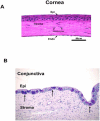Tear film mucins: front line defenders of the ocular surface; comparison with airway and gastrointestinal tract mucins
- PMID: 23954166
- PMCID: PMC4222248
- DOI: 10.1016/j.exer.2013.07.027
Tear film mucins: front line defenders of the ocular surface; comparison with airway and gastrointestinal tract mucins
Abstract
The ocular surface including the cornea and conjunctiva and its overlying tear film are the first tissues of the eye to interact with the external environment. The tear film is complex containing multiple layers secreted by different glands and tissues. Each layer contains specific molecules and proteins that not only maintain the health of the cells on the ocular surface by providing nourishment and removal of waste products but also protect these cells from environment. A major protective mechanism that the corneal and conjunctival cells have developed is secretion of the innermost layer of the tear film, the mucous layer. Both the cornea and conjunctiva express membrane spanning mucins, whereas the conjunctiva also produces soluble mucins. The mucins present in the tear film serve to maintain the hydration of the ocular surface and to provide lubrication and anti-adhesive properties between the cells of the ocular surface and conjunctiva during the blink. A third function is to contribute to the epithelial barrier to prevent pathogens from binding to the ocular surface. This review will focus on the different types of mucins produced by the corneal and conjunctival epithelia. Also included in this review will be a presentation of the structure of mucins, regulation of mucin production, role of mucins in ocular surface diseases, and the differences in mucin production by the ocular surface, airways and gastrointestinal tract.
Keywords: conjunctiva; cornea; mucin; proliferation; secretion; tears.
Copyright © 2013 Elsevier Ltd. All rights reserved.
Figures










References
-
- Aragona P, Romeo GF, Puzzolo D, Micali A, Ferreri G. Impression cytology of the conjunctival epithelium in patients with vernal conjunctivitis. Eye (Lond) 1996;10(Pt 1):82–85. - PubMed
-
- Argueso P, Balaram M, Spurr-Michaud S, Keutmann HT, Dana MR, Gipson IK. Decreased levels of the goblet cell mucin MUC5AC in tears of patients with Sjogren syndrome. Invest Ophthalmol Vis Sci. 2002;43:1004–1011. - PubMed
Publication types
MeSH terms
Substances
Grants and funding
LinkOut - more resources
Full Text Sources
Other Literature Sources
Medical

